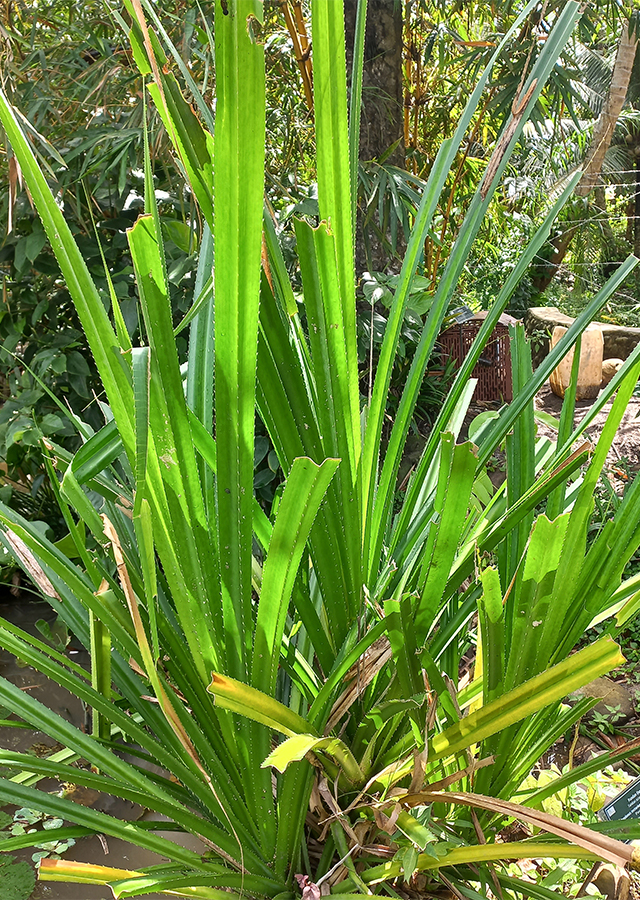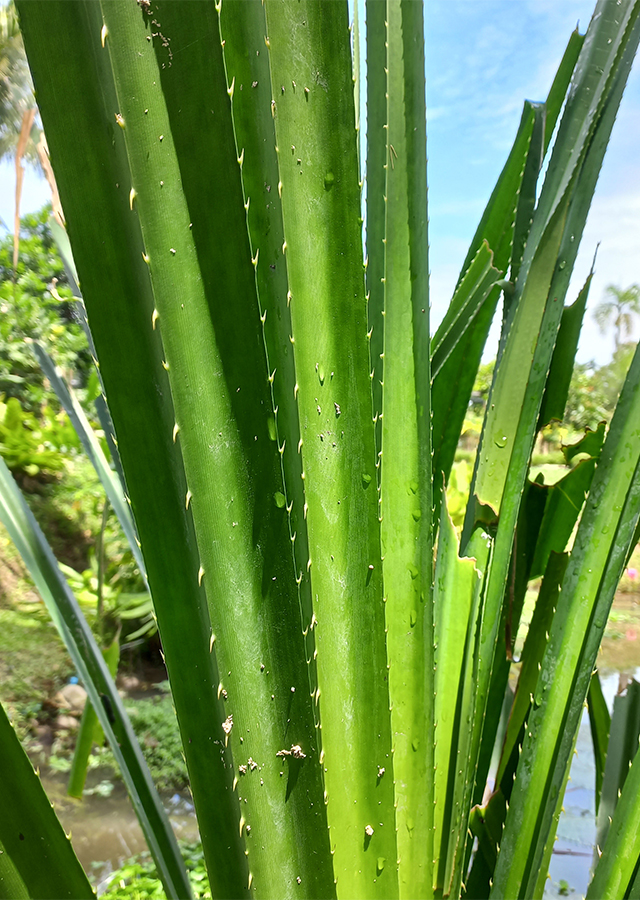Traditional Herbs from Pandanus tectorius
boils
- Prepare enough pandan duri leaves and wash them until clean.
- Crush them until they become a paste.
- Add salt and lime juice to taste.
- Apply the paste on the boils.
dizziness
- Take fresh pandan duri leaves and wash them until clean.
- Crush the leaves into a paste and add a little oil.
- Pulse on the forehead.
What is Pandanus tectorius Looks like??



Parts of Pandanus tectorius that could be used
- Leaves
- Bark
- Roots
Pandanus tectorius Distribution
Thorn pandan comes from the Pacific region (Micronesia, French Polynesia, New Caledonia, Solomon Islands, and Vanuatu), the Philippines, Papua New Guinea, parts of Indonesia (including Irian Jaya, Java, and Maluku), and Queensland (Australia). Pandan thorn is a multipurpose plant, because people believe it has many uses, including as food, fragrance, fiber, compost, building materials, medicines, ornamental and shade plants, coastal erosion control plants, windbreaks and boundary markers. This plant produces fruit that can be consumed fresh or processed, can be made into juice drinks, cooked as jam or dried and made into flour, pasta or cakes. The flower buds and inner base of the young leaves can also be consumed as a vegetable. The aromatic leaves can be used to scent rice dishes. As well as the aqueous extract distilled from male flowers (kewra water) is used as a flavoring in desserts and drinks. In its use as a building and craft material, the stem and large branches are often used to build houses, and the leaves and roots are used as materials for making roofs, walls, baskets, hats, mats, ropes, bags, pillows and nets. . Traditionally, this species is also believed to be efficacious as a treatment for various diseases. All parts of the plant have various medicinal uses and have long been used in traditional medicine in various countries including India and the Philippines. Based on its use as a cosmetic ingredient, the male flower of thorn pandan produces essential oil which is widely used as an ingredient in making perfume, hair oil and soap. Apart from that, thorn pandan roots are also a source of black dye used in weaving.Agroecology of Pandanus tectorius
Pandan thorn is a lowland plant that can naturally be found in tropical and subtropical coastal areas, especially on sandy and rocky beaches, coral terraces, including brackish areas on salty soil, peat swamps. In the wild, this species is rarely found at altitudes above 20 m above sea level, but currently it is widely cultivated at altitudes up to 600 m above sea level. This species prefers humid and subhumid environments, with warm to hot temperatures throughout the year, where the average annual temperature ranges from 24 - 28 °C, the average temperature of the hottest month is 28 - 36 °C and the coldest month is 17 - 25 °C with average annual rainfall varying in the range of 1,500 - 4,000 mm with no dry season or short dry season for 2 - 3 months. Pandan thorn is tolerant of waterlogging and drought so it can grow in dry and flooded soil. This plant likes a position with full sun, and is mostly found in open areas, but can also grow in shade (30-50%), and will not tolerate shade above 70%. Grows well in soil with a sandy, moist, well-drained soil texture. This species is also quite tolerant of fire (low-medium intensity), salt and wind.
Morphology of Pandanus tectorius
- The root develops numerous aerial roots and supporting roots from the lower part of the trunk or side branches.
- The stem is erect, branched, covered with sharp conical spines, the bark is grayish brown or reddish, smooth or scaly, with characteristic scars wavy leaf lesions and rows of spines.
- Leaves are dark green, linear in shape, long and straight, about 4-8 cm wide and 80-180 cm long, with many spines along the edges and bottom of the midrib. fold, have 'V' cross-section, and arranged spirally in clusters at the ends of the branches.
- The flowers are dioecious, bearing male and female flowers on separate plants. The male flowers are small, white, fragrant, pendant-like, arranged in racemes or branching in clusters,. with large, conspicuous white bracts, and only last about one day. The female flowers are pendulous, borne on globose to subglobose flower heads.
- The fruit is a compound fruit that resembles a pineapple, ovate-oval in shape, angular, fibrous, fleshy. Consisting of 40-200 wedge-shaped fleshy 'keys', green in color and turning orange when ripe.
- Seeds are reddish brown, obovoid, ellipsoid or oval in shape.
Cultivation of Pandanus tectorius
- Propagation can be done generatively (seeds) and vegetatively (rooted branch or stem cuttings).
- To speed up germination, before sowing soak the drupes in cold tap water for 5 days, changing the water every day. Viable seeds will float .Germination takes about 2 months.
- Propagate by cuttings, select and cut the stem with supporting roots, and the leaf crown is trimmed but not cut, then the cuttings are inserted obliquely into the medium. plant.
- Pandan thorn plants that emerge from propagation through seeds tend to start flowering at around 15 years of age, while plants from cuttings start to flower much earlier, namely at 6 years of age, often 3-4 years.
Pandanus tectorius, more details :
Chemical Content of Pandanus tectoriusEssential oils (diterpene, d-linalool, phenylethyl acetate, citral, phenylethyl alcohol ester, ester of phthalic acid, fatty acids, steroptene), alkaloids, glycosides, isoprene esters, tannins, phytosterols, saponins, phenolic compounds (pandanusphenol A and B) , amino acids, terpenoids, flavonoids, steroids, pandanusin A, furanocoumarins, coumarins, monoglycerides, monosaccharides.
Benefits of Pandanus tectorius
Strengthens gums, treats headaches, earaches, arthritis, stomach spasms, arthritis, boils, hemorrhoids, colds, hepatitis, dysuria, asthma, cancer, filaria, vaginal discharge, leprosy, smallpox, scabies, syphilis, prevents miscarriage, relieves pain and accelerates wound healing, overcomes abnormal menstrual bleeding after giving birth, jaundice, colic and restless babies, relieves vomiting, induces infertility, is a sedative, acts as a diuretic, aphrodisiac, and cardiotonic (strengthens heart performance).
Simplisia of Pandanus tectorius
Another Facts for Pandanus tectorius :
Synonym of Pandanus tectoriusCorypha laevis (Lour.) A.Chev., Pandanus absonus H.St.John, Pandanus adscendens H.St.John
Habitus of Pandanus tectorius
Tree. Annual tree, grows up to 14 m tall
Habitat of Pandanus tectorius
- Forest", "Coast", "Roadside", "Rocky Area", "Grassland", "Land
No comments:
Post a Comment